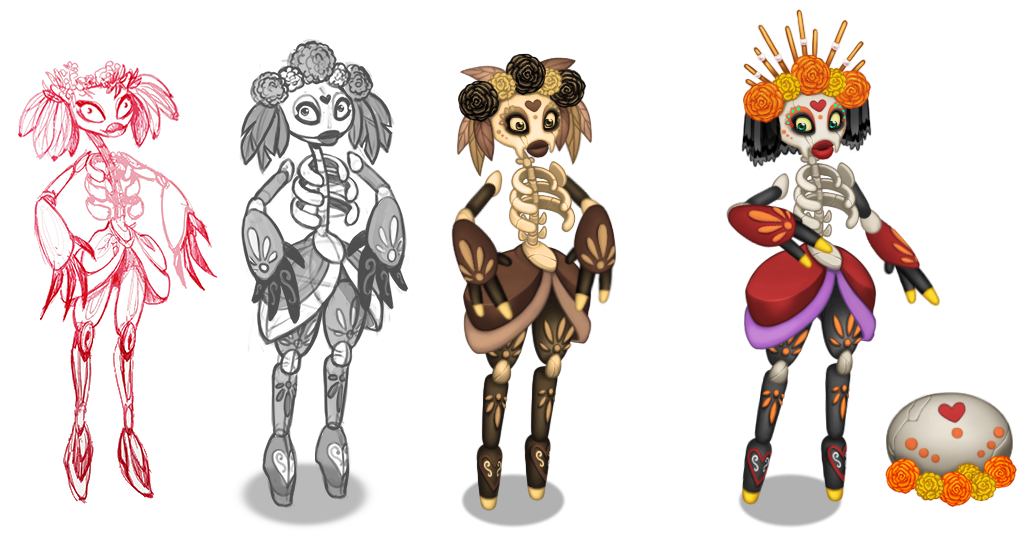
As the Beat Hereafter arrives on Bone Island for the very first time, the Monsters are thrilled to welcome the Seasonal Clavavera and adorn their island with bright, colorful and celebratory decorations for this Día de los Muertos-inspired celebration.
Each and every one of our Seasonal Events are crafted with care, research, and respect for their sources of inspiration. With the Monster designs, Seasonal island reskins, and decorations drawing on thoroughly considered cultural references, our hope is to craft events and celebrations that make the My Singing Monsters community feel included, respected and represented. In our excitement to release Clavavera last year, it was identified that a step we missed during the creation of the Beat Hereafter was consulting with subject matter experts on Mexican culture and imagery.
With this in mind, we’ve worked closely with Geogrify, a content culturalization and localization consultancy, to examine the designs, decorations, and choices made for this year’s event. That way, we’ve ensured that we’re representing our cultural references as accurately and respectfully as possible.

The design development of Clavavera.
Clavavera’s appearance is inspired by the figure of La Catrina, and named as a portmanteau of the instrument ‘claves’, a pair of wooden sticks which create a bright, piercing clack, and calavera, the candy skull decorations for which Día de los Muertos is so well known. Special attention was paid to respect cultural aspects like the inclusion of accurately-colored cempasúchil (the iconic flowers) in the character’s crown to keep it more aligned with traditional depictions. Its multicolored feathers have been shed like leaves in autumn, replaced with a lace-like veil and branches to create a radiating and crown-like effect.

Bone Island decor during the Beat Hereafter.
During the Beat Hereafter, Bone Island is adorned with ofrendas, or offerings placed on altars to the deceased intended to welcome them to the celebration. The ofrendas are commonly decorated with statues, candles, favorite foods and sweets, such as mole, candy and pan dulce (sweet breads), calaveras (sugar skulls), and bright orange and yellow cempasúchil (marigolds). Each of the items coming together to create the ofrenda draw on the elements (fire, water, earth, air), connecting the living and the dead in celebration. (Fortuitously, Bone Island also has the Elements of Fire, Water and Earth!)

Concept artwork of Rock Obstacles for the Beat Hereafter.
Calaveras, the decorated sugar skulls, are featured prominently throughout the Beat Hereafter, from Clavavera’s own design, to the clay and sugar decorations scattered throughout the island. Created to be gifts for children or as offerings to be placed with the ofrendas, the calaveras are crafted to represent those who have passed away, and to celebrate rebirth into the next stage of life.
It’s believed that the smell of cempasúchil, the Aztec marigold, guides ancestors back to their loved ones during the celebration of Día de los Muertos. These colorful orange and yellow flowers cover Bone Island during the Beat Hereafter, in bouquets, on ofrendas, and adorning Monsters like Clavavera. Their bright, cheerful colors are intended to highlight the celebratory spirit of the event.

As ever, the passion of the My Singing Monsters community, and the encouragement to improve keep motivating us. We’re excited to present the Beat Hereafter to everyone this year thanks to your support and enthusiasm. We look forward to showing you even more exciting Seasonal Events in the future!
FAQ
Q: Is Clavavera’s new appearance permanent?
A: Yes, Clavavera’s new appearance will immediately and permanently take effect as of the launch of the Beat Hereafter. Out of respect for the culture from which it’s inspired, the old appearance will not be made available as an alternative Costume moving forward.
Q: Who did Big Blue Bubble consult with when developing the Beat Hereafter?
A: Geogrify, a content culturalization and localization consultancy. They were incredibly helpful and supportive of our effort to do this event justice, and we are very thankful for their contributions!
Q: Where can I learn about Día de los Muertos?
A: You can learn more about the Mexican holiday of the Day of the Dead, the Día de los Muertos, online or at your local library. Here are some of our favorite resources:
https://www.history.com/topics/halloween/day-of-the-dead
https://www.gob.mx/inafed/articulos/dia-de-muertos-tradicion-mexicana-que-trasciende-en-el-tiempo
Glossary:
Día de los Muertos – The Day of the Dead celebration
Claves – A wooden musical instrument
Calavera – Decorative skulls, often used as a symbol of Día de los Muertos
Calaca – Decorative skeletons used during the festival
La Catrina – A famous piece of imagery created by Mexican artist José Guadalupe Posada
Cempasúchil – Aztec marigolds
Ofrenda – An offering to the dead placed on altars